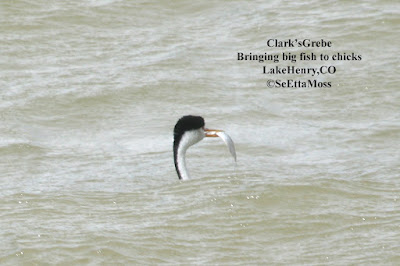Grebe chick swallowing fish

I returned to Lake Henry yesterday to watch the grebes some more and try to get some better pics of the chicks (they are so small, the pics of them do not enlarge well). I might add here that Clark's Grebes look quite similar to Western Grebes but the white on their faces goes just above the eye and onto the lores, while the white goes below the eye in Western Grebes. Also, Clark's Grebes have brighter yellow bills, with paler backs, less extensive black on flanks, and some more subtle characteristics. There is a caveat regarding characteristics since during winter some Clark's Grebes have an intermediate plumage including the white not extending above the eye. I was delighted to watch as a parent grebe fed a fish, which looked awfully big for the size of this chick, to a chick. In the top pic, the Clark's Grebe parent has come to the surface with a fish in it's beak. In the middle pic, the chick has the fish in it's beak and with it's head pointed up ...
